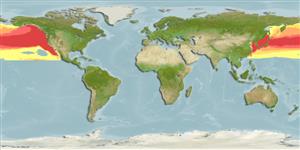>
Beloniformes (Needle fishes) >
Scomberesocidae (Sauries)
Etymology: Cololabis: Greek, kolos = short, truncated + Latin, labia = lips (Ref. 45335); saira: From the Japanese word 'saira' meaning spear (Ref. 6885).
Environment: milieu / climate zone / depth range / distribution range
Ecologia
marinhas; oceanódromo (Ref. 51243); intervalo de profundidade 0 - 230 m (Ref. 9339). Subtropical; 67°N - 18°N, 117°E - 108°W (Ref. 54338)
North Pacific: Korea (Ref. 37630) and Japan eastward to Gulf of Alaska and southward to Mexico. Highly migratory species.
Comprimento de primeira maturação / Tamanho / Peso / Idade
Maturity: Lm 23.7, range 25 - 28 cm
Max length : 40.0 cm SL macho/indeterminado; (Ref. 39882); peso máx. publicado: 180.00 g (Ref. 56527); idade máx. registrada: 4 anos (Ref. 72462)
Descrição suscinta
Chaves de identificação | Morfologia | Morfometria
Espinhos dorsais (total) : 0; Raios dorsais (total) : 9 - 12; Espinhos anais: 0; Raios anais : 12 - 15; Vértebras: 62 - 69. Caudal fin broadly and finely forked; pectorals small, truncate, first ray notably flattened (Ref. 6885). Dark green to blue on dorsal surface, silvery below, small bright blue blotches distributed haphazardly on sides; fins on lower part of body pale, others with darkened rays (Ref. 6885). Branchiostegal rays: 12-15 (Ref. 36573).
Adults are generally found offshore, usually near surface, in schools (Ref. 2850). Juveniles associate with drifting seaweed (Ref. 12114, 12115). Feed on small crustaceans, and eggs and larvae of fishes. May glide above the surface of the water when moving away from predators. Prey of Thunnus alalunga and other scombrids (Ref. 9339). Oviparous, with larvae neustonic (Ref. 36573). Eggs are attached to one another and to floating objects via filaments on the shell surface (Ref. 36573). Utilized dried or salted, canned and frozen; also used for fishmeal and pet food; can be pan-fried and broiled (Ref. 9988).
Eschmeyer, W.N., E.S. Herald and H. Hammann, 1983. A field guide to Pacific coast fishes of North America. Boston (MA, USA): Houghton Mifflin Company. xii+336 p. (Ref. 2850)
Status na Lista Vermelha da UICN (Ref. 130435: Version 2024-1)
Ameaça para os humanos
Harmless
Uso pelos humanos
Pescarias: altamente comercial
Ferramentas
Relatórios especiais
Baixar XML
Fontes da internet
Estimates based on models
Preferred temperature (Ref.
123201): 4.6 - 14.8, mean 8 °C (based on 99 cells).
Índice de diversidade filogenética (Ref.
82804): PD
50 = 0.7812 [Uniqueness, from 0.5 = low to 2.0 = high].
Bayesian length-weight: a=0.00240 (0.00124 - 0.00464), b=3.15 (2.97 - 3.33), in cm total length, based on LWR estimates for this species & (Sub)family-body (Ref.
93245).
Nível Trófico (Ref.
69278): 3.7 ±0.44 se; based on food items.
Resiliência (Ref.
120179): Elevada, tempo mínimo de duplicação da população menor que 15 meses (K=0.3-0.6; tmax=2).
Prior r = 0.94, 95% CL = 0.62 - 1.41, Based on 2 data-limited stock assessments.
Fishing Vulnerability (Ref.
59153): Low to moderate vulnerability (32 of 100).
Climate Vulnerability (Ref.
125649): Low vulnerability (25 of 100).
Nutrients (Ref.
124155): Calcium = 162 [60, 372] mg/100g; Iron = 1.51 [0.75, 3.55] mg/100g; Protein = 17.6 [15.5, 19.6] %; Omega3 = 0.407 [0.193, 1.210] g/100g; Selenium = 31 [15, 63] μg/100g; VitaminA = 19 [6, 70] μg/100g; Zinc = 0.738 [0.515, 1.100] mg/100g (wet weight);
